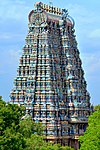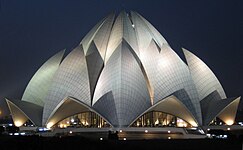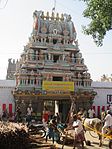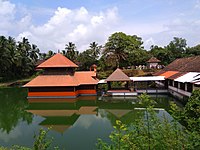Padaratha
Republic of Padaratha పాదరథ కుడఉయార్చు Pādaratha Kuḍuyārcu | |
|---|---|
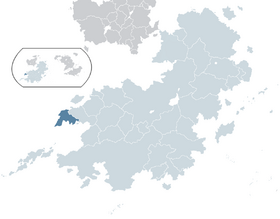 Padaratha (dark blue) located within Coius (light blue). | |
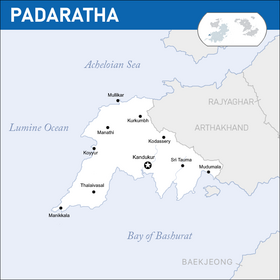 Location of Padaratha | |
| Capital and largest city | Kandukur |
| Official languages | Estmerish Tamisari |
| Recognised national languages | Pumil Valarna Chatra Sahaput |
| Ethnic groups (2020) | |
| Religion (2020) | |
| Demonym(s) | Padarathan |
| Government | Federal parliamentary constitutional republic |
| Hiriya Prasanna | |
• Premier | Gaurav Mahamuni |
| Legislature | Samakhya Samavesam |
| Senet | |
| Sahayakula Illu | |
| Independence from Estmere | |
| 1 November 1946 | |
| 18 May 1962 | |
| Area | |
• Total | 412,196 km2 (159,150 sq mi) |
| Population | |
• 2020 estimate | |
• 2013 census | 95,883,247 |
| GDP (PPP) | 2020 estimate |
• Total | |
• Per capita | |
| GDP (nominal) | 2020 estimate |
• Total | |
• Per capita | |
| Gini | 31.5 medium |
| HDI | medium |
| Currency | Pagoda (ಪ್) (PGD) |
| Driving side | right |
| Calling code | +86 |
Padaratha, officially the Republic of Padaratha, is a country in Satria. It borders Arthasthan to its east, and shares maritime borders with Baekjeong and Senria. It also shares a maritime border with Minkathala, which has been occupied by Arthakhand since 1984. Padaratha has a population of 101 million, of which 8.5 million live in the capital of Kandukur.
The first humans arrived in Satria around 55,000 years ago, with the Barayan Site revealing that they had settled in modern Padaratha by 47,000 BCE. By the 4th or 3rd millenium BCE Proto-Purvan had spread to Padaratha, and was likely the most widespread indigineous language in Satria. After the 2nd millenium BCE Proto-Satro-Pardarian began arriving from the east, and by 1200 BCE Parbhan had largely begun to supplant Purvan in the east. This process would continue until the modern-day, gradually pushing the Purvanic languages further west.
From 3500 BCE to 1000 BCE the area was home to the Vistra and Narpra cultures, which coincided with the legendary Puliraj, Jalariraj, and semi-legendary Puranagar dynasties. -More ancient Satrian stuff here-
-Medieval Satrian stuff here-
Etymology
The etymology of the name Padaratha means "Western Chariot", and refers to the title of the same name. It comes from the Tamisari పడమర Paḍamara "West", and రథం Rathaṁ "Chariot", itself from the Parbhan रथ rátha. The Swaraj movement coined the term for the majority-Purvan region of Satria under Estmerish rule.
Under Estmerish rule, Padaratha was commonly known as Canducca, after the Canducca Presidency. The Canducca Presidency was the largest of three Presidencies, until they were merged in 1912 into Estmerish Satria.
History
Ancient Padaratha
Medieval Padaratha
Early Modern Padaratha
Modern Padaratha
Geography
Climate
Biodiversity
Politics and government
Politics
Government
Administrative divisions
Legal system
Military
Foreign relations
Human rights and corruption
Economy
Industries
Socio-economic challenges
Demographics
Religion in Padaratha as of 2020.
Urban centres
Language
Religion
Padratha's constitution guarantees freedom of religion, and establishes Padaratha as a secular state. The country is religiously diverse, with Zohism being the largest religion, followed by 80 percent of the population. The majority of Padarathan Zohists follow the Theuku school, followed by minorities of followers of the Busothaq and Tsandau schools. Padaratha has the second largest Zohist population in the world, and the largest in Satria. Zohism first arrived in the 3rd century BCE, from dissidents fleeing Xiang persecution, but it did not begin to spread until after the 8th century CE when merchants and clergy from Senria arrived. -Some more non-history stuff here-
-Ashram-
Sotirianity
-Badi, Tulyata, and other-
Jalandukur Temple, an Ashram Temple in Jalandukur
Ambedesar Lake Temple, a Badi Temple in Ambedesar



